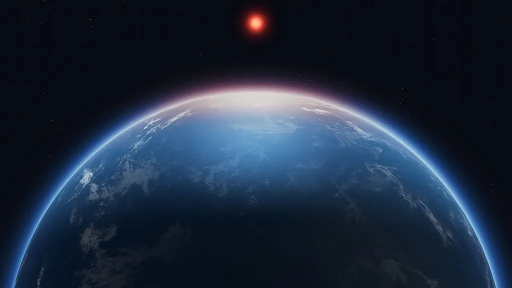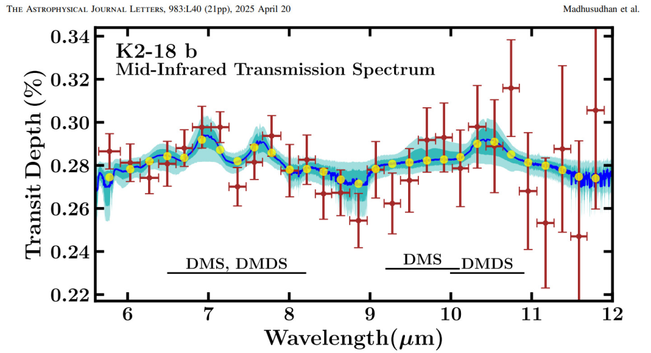New model helps to figure out which distant planets may host life
#Astronomy #Space #NASA #Exoplanets #Astrobiology #SpaceExploration #Habitability #AlienLife #Astronomy #Biosignatures #SpaceScience #NExSS #HabitableWorlds #NautilusTelescope #Astrophysics
https://the-14.com/new-model-helps-to-figure-out-which-distant-planets-may-host-life/
#Biosignatures
Finding a Better Way to Distinguish Life from Non-Life
https://www.universetoday.com/articles/finding-a-better-way-to-distinguish-life-from-non-life
A Complex Systems Approach to Exoplanet Atmospheric Chemistry: New Prospects for Ruling Out the Possibility of Alien Life As We Know It
https://iopscience.iop.org/article/10.3847/PSJ/adcc27
Scientists skeptical about recent claims that signs of life were possibly detected on exoplanet
https://www.cbc.ca/news/science/k218b-exoplanet-skepticism-1.7520656
"Jake Taylor, a planetary scientist who also studies exoplanets using JWST data, used that data and examined it using a different method than the Madhusudhan-led study and was unable to replicate the findings. He published his results on the pre-print site ArXiv."
#KnowledgeByte: Recent observations by the James Webb Space Telescope (JWST) have provided the "most promising signs yet" of potential #Biosignatures in the atmosphere of the #Exoplanet K2-18b, located 124 light-years away within its star's habitable zone.
https://knowledgezone.co.in/posts/Evidence-of-Alien-Life-Found-68011e4ea835e9f9769c2970
Biosignature Hype
I was thinking just the other day that I haven’t posted much in either the Astrohype or the Bad Statistics folders on this blog. Well today I found an item that belongs in both categories. Many people will have seen the widespread press coverage of a misleading claim of the discovery of alien life; see, e.g., here. This misleading press coverage is based on a misleading press release from the University of Cambridge which you can find here.
The story is based on a paper in the pay-to-publish Astrophysical Journal Letters with the title “New Constraints on DMS and DMDS in the Atmosphere of K2-18 b from JWST MIRI“. The DMS and DMDS in the title refer to Dimethyl Sulphide and Dimethyl Disulphide respectively. These are interpreted by the authors as biosignatures.
There are two main problems with this claim. One is that DMS and DMDS are not necessarily biosignatures in the first place; see here for the reasons. The other is that there isn’t even any evidence for the detection of DMS or DMDS anyway. Here is the spectrum of which the lead author of the paper, Prof. Nikku Madhusudhan, has claimed “the signal came through loud and clear”.
Yeah, right. In statistical terms this is a non-detection. The Bayes Factor used in the paper to quantify the evidence for a model with DMS and/or DMDS over one without is just 2.62 in the logarithm. That’s not a detection by any stretch of the imagination; to be anywhere near convincing a Bayes Factor has to be at least 100. The subsequent cherry-picking of the data to improve the apparent probability of a detection is just statistical flummery.
Notice that the use of the phrase “Constraints on” in the title of the paper does not indicate that the article presents evidence that a detection has been made. That the claim has somehow morphed into the “the strongest evidence for life beyond our solar system” is absurd. The most charitable thing I can say is that Prof. Madhusudhan must have been carried away by enthusiasm. This doesn’t reflect very well on Cambridge University either.
This episode worries me greatly. This is a time of increasing hostility towards science and this sort of thing can only make matters worse. Scientists need to be much more careful in communicating the uncertainties in their results.
UPDATE: There’s a now paper on arXiv here that argues that a straight line is a better fit to the data, in other words that there is no strong statistical evidence for spectral features at all.
#BayesFactor #Biosignatures #DimethylDisulphide #DimethylSulphide #ProfNikkuMadhusudhan
New Constraints on DMS and DMDS in the Atmosphere of K2-18 b from JWST MIRI: https://arxiv.org/abs/2504.12267 -> Strongest hints yet of biological activity outside the solar system: https://www.eurekalert.org/news-releases/1080558 - but see also https://iopscience.iop.org/article/10.3847/1538-4357/ad8565 (Evidence for Abiotic Dimethyl Sulfide in Cometary Matter) and https://iopscience.iop.org/article/10.3847/2041-8213/ad74da (Abiotic Production of Dimethyl Sulfide, Carbonyl Sulfide, and Other Organosulfur Gases via Photochemistry: Implications for #Biosignatures and Metabolic Potential)!
Could life in our Universe be more rare than we think?
In the Search for Extraterrestrial Life, This Surprising Result May Bring us Closer to a Groundbreaking Discovery
“A single positive detection would change everything,... but even if we don’t find life, we’ll be able to quantify how rare – or common – planets with detectable biosignatures really might be.”
#life #extraterrestriallife #biosignatures
https://thedebrief.org/in-the-search-for-extraterrestrial-life-this-surprising-result-may-bring-us-closer-to-a-groundbreaking-discovery/
Habitability and Biosignatures
https://arxiv.org/abs/2503.22990
"The present work provides an introductory compendium of key aspects of habitability and biosignatures of importance to the search for life in exoplanetary environments. Basic concepts of planetary habitability are introduced along with essential requirements for life as we know it and the various factors that affect habitability."
The Detectability of CH4/CO2/CO and N2O #Biosignatures Through Reflection Spectroscopy of Terrestrial Exoplanets: https://iopscience.iop.org/article/10.3847/1538-3881/ad88eb -> Life Is Like a Box of Potential Biosignatures: https://aasnova.org/2025/02/11/life-is-like-a-box-of-potential-biosignatures/
Calendrier de l' #avent de l' #exobiologie (12/24)
Quelles pourraient être les traces d'une vie primitive martienne disparue ?
Avec beaucoup de chance, des #biosignatures claires et sans équivoque seront découvertes sur Mars dans les décennies à venir avec des rovers ou un retour d'échantillons.
(note : l'image d'illustration a été générée par IA... on n'a rien trouvé de tel sur Mars (et probablement on ne trouvera jamais rien de tel)
“In the media, everybody was like, ‘Oh, maybe we have detected life!’”. Researchers will need to be more careful about interpreting DMS #biosignatures 🦠. https://www.science.org/content/article/what-presumed-sign-life-doing-dead-comet
Energy-ordered resource stratification as an agnostic signature of life
#biosignatures #astrobiology
The Perseverance rover has sampled a silica-cemented carbonate! That's excellent material for preserving possible biosignatures.
#astrobiology #biosignatures #Mars #Martian
https://phys.org/news/2024-04-sampled-nasa-perseverance-embodies-rover.amp
Astrobiology Journal covers appreciation post
Atacama Rover Astrobiology Drilling Studies (ARADS)
https://liebertpub.com/toc/ast/23/12
Featuring a collection of papers about searching and identifying biosignatures in a well-studied terrestrial Mars-analog environment, in the hyper-arid Atacama Desert.
📷 "Rover Under the Milky Way" NASA/CampoAlto/Victor Robles https://www.nasa.gov/image-article/rover-under-milky-way-atacama-rover-astrobiology-drilling-studies/
#astrobiology #Atacama #ARADS #rover #chile #space #astronomy #astrodon #life #biosignatures #science #enineering #STEM
Carnegie Scientists Share How the Giant Magellan Will Change Astronomy
https://carnegiescience.edu/carnegie-scientists-share-how-giant-magellan-will-change-astronomy
#carnegie #science #GiantMagellan #GiantMagellanTelescope #GMT #telescope #LasCampanas #LCO #observatory #Chile #Atacama #desert #astronomy #astrophysics #astrodon #astronomers #universe #planets #exoplanets #astrobiology #biosignatures #stars #clusters #galaxies #darkmatter #solarsystem #STEM
Next up, we’ve got Victoria Meadows on the feasibility of detecting #biosignatures in the TRAPPIST-1 system.
Vici reminds us that Earth has a rich history of biosignatures, thanks to microbes. She thinks that the best bet to search for life elsewhere is the TRAPPIST-1 system because of the observability and expected atmospheric compositions. So they computed different models to test the detectability. #ExSSV
Good morning friends! I am back to tell you more from #ExSSV - apologies for skipping yesterday, my mind wasn’t up for it.
Today, we start with #habitability, #biosignatures #technosignatures.
We kick off the session with Tiffany Kataria on assessing #conditions for the origin of #life on #exoplanet. For Tiffany, the origin of life is from geophysics to biophysics and important - habitable doesn’t mean inhabited and the origin of life is a way to rule out these false positives. #ExSSV
The LIFE telescope passed its first test, detecting biosignatures on Earth
https://phys.org/news/2024-03-life-telescope-biosignatures-earth.html #LIFE #telescope #biosignatures #Earth #intelligence? #atmospheric #spectrum
The LIFE Telescope Passed its First Test: It Detected Biosignatures on Earth. https://www.universetoday.com/166002/the-life-telescope-passed-its-first-test-it-detected-biosignatures-on-earth/ #largeinterferometerforexoplanets #biosignatures #carbondioxide #habitability #atmosphere #exoplanets #telescopes #chemistry #methane #ozone
If Exoplanets Have Lightning, it’ll Complicate the Search for Life https://www.universetoday.com/165853/if-exoplanets-have-lightning-itll-complicate-the-search-for-life/ #atmosphericchemistry #exoplanetatmospheres #reducingatmosphere #anoxicatmosphere #biosignatures #habitability #atmosphere #exoplanets #chemistry #lightning



